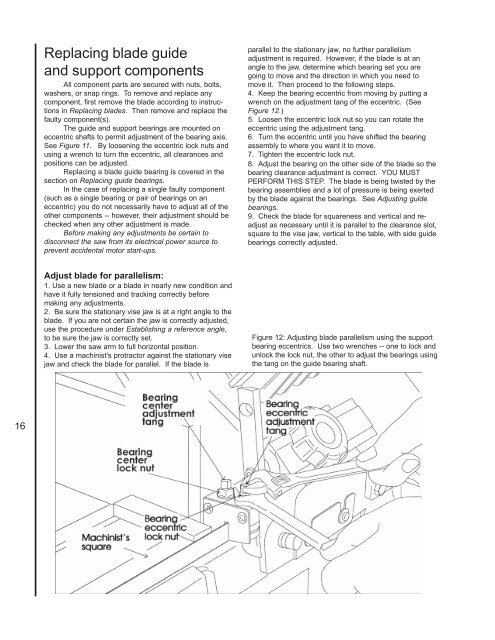7 x 12 Cut-off Band Saw - Igor Chudov
7 x 12 Cut-off Band Saw - Igor Chudov
7 x 12 Cut-off Band Saw - Igor Chudov
Create successful ePaper yourself
Turn your PDF publications into a flip-book with our unique Google optimized e-Paper software.
16<br />
Replacing blade guide<br />
and support components<br />
All component parts are secured with nuts, bolts,<br />
washers, or snap rings. To remove and replace any<br />
component, first remove the blade according to instructions<br />
in Replacing blades. Then remove and replace the<br />
faulty component(s).<br />
The guide and support bearings are mounted on<br />
eccentric shafts to permit adjustment of the bearing axis.<br />
See Figure 11. By loosening the eccentric lock nuts and<br />
using a wrench to turn the eccentric, all clearances and<br />
positions can be adjusted.<br />
Replacing a blade guide bearing is covered in the<br />
section on Replacing guide bearings.<br />
In the case of replacing a single faulty component<br />
(such as a single bearing or pair of bearings on an<br />
eccentric) you do not necessarily have to adjust all of the<br />
other components -- however, their adjustment should be<br />
checked when any other adjustment is made.<br />
Before making any adjustments be certain to<br />
disconnect the saw from its electrical power source to<br />
prevent accidental motor start-ups.<br />
Adjust blade for parallelism:<br />
1. Use a new blade or a blade in nearly new condition and<br />
have it fully tensioned and tracking correctly before<br />
making any adjustments.<br />
2. Be sure the stationary vise jaw is at a right angle to the<br />
blade. If you are not certain the jaw is correctly adjusted,<br />
use the procedure under Establishing a reference angle,<br />
to be sure the jaw is correctly set.<br />
3. Lower the saw arm to full horizontal position.<br />
4. Use a machinist's protractor against the stationary vise<br />
jaw and check the blade for parallel. If the blade is<br />
parallel to the stationary jaw, no further parallelism<br />
adjustment is required. However, if the blade is at an<br />
angle to the jaw, determine which bearing set you are<br />
going to move and the direction in which you need to<br />
move it. Then proceed to the following steps.<br />
4. Keep the bearing eccentric from moving by putting a<br />
wrench on the adjustment tang of the eccentric. (See<br />
Figure <strong>12</strong>.)<br />
5. Loosen the eccentric lock nut so you can rotate the<br />
eccentric using the adjustment tang.<br />
6. Turn the eccentric until you have shifted the bearing<br />
assembly to where you want it to move.<br />
7. Tighten the eccentric lock nut.<br />
8. Adjust the bearing on the other side of the blade so the<br />
bearing clearance adjustment is correct. YOU MUST<br />
PERFORM THIS STEP. The blade is being twisted by the<br />
bearing assemblies and a lot of pressure is being exerted<br />
by the blade against the bearings. See Adjusting guide<br />
bearings.<br />
9. Check the blade for squareness and vertical and readjust<br />
as necessary until it is parallel to the clearance slot,<br />
square to the vise jaw, vertical to the table, with side guide<br />
bearings correctly adjusted.<br />
Figure <strong>12</strong>: Adjusting blade parallelism using the support<br />
bearing eccentrics. Use two wrenches -- one to lock and<br />
unlock the lock nut, the other to adjust the bearings using<br />
the tang on the guide bearing shaft.
















